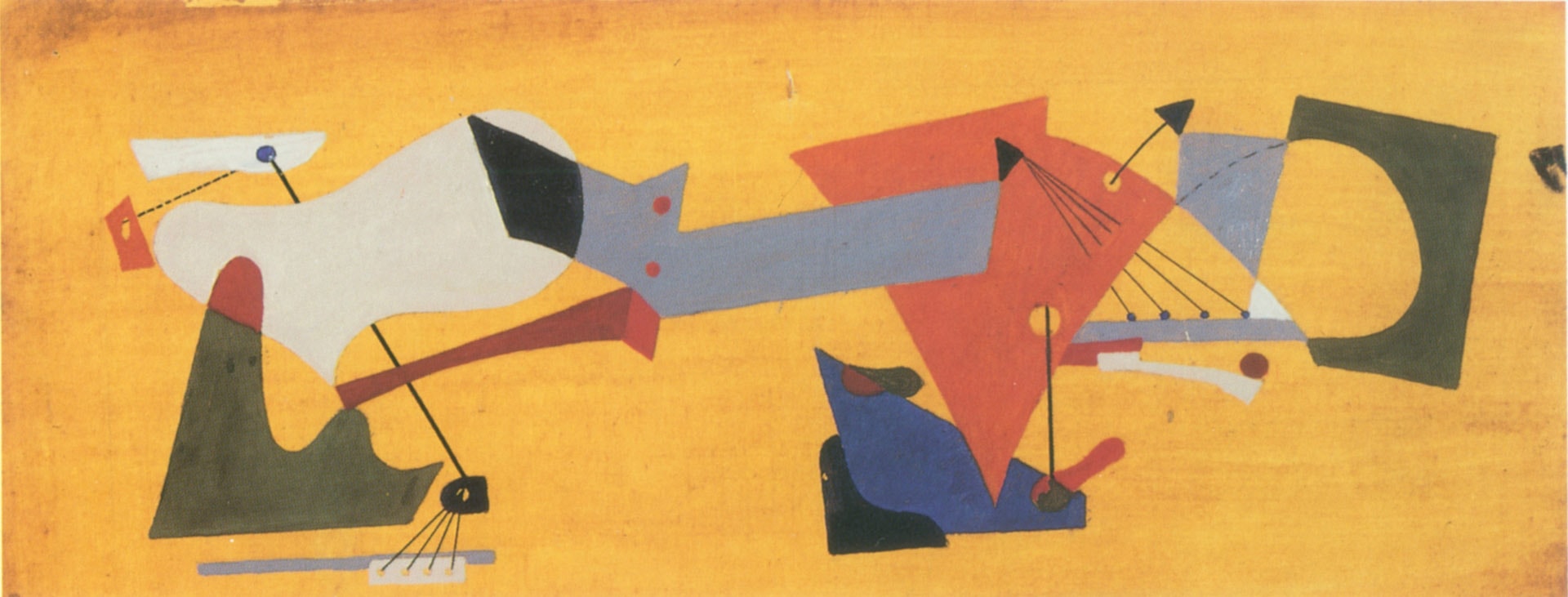Mural Sketch No.1
Year: 1937
Type: Painting
Catalog #: SF_0040
Current Location:
Private Collection
Exhibition History:
Tufts show, 1992; “Esphyr Slobodkina: Journey into Abstraction,” Kraushaar Galleries, October 1-30, 2004; “1937: American Abstract Art” Snyder Fine Art, Sept.8-Oct. 28, 1995
“Rediscovering Slobodkina: A Pioneer of American Abstraction,” Heckscher Museum, Huntington NY, Dec 2008-Mar 2009,
Samuel P. Harn Art Museum, Gainesville, FL, Jun 16 – Sept 6, 2009;
Naples Museum of Art, Naples, FL, Oct 1 – Dec 29, 2009.
Sheldon Museum of Art, Licoln Nebraska, Jan-April 2010.
Dimensions:
9.25 x 23 1/2
Slobodkina created 5 WPA mural sketches. She worked for the WPA in 1936-1938, and was an assistant to Hananiah Harari. Because Harari didn’t really need help, Slobodkina able to work on her own (The Life and Art of Esphyr Slobodkina, Tufts University Art Gallery, 1992, p.15). She recalls: “Mr. Harari might have been a good, energetic worker for the cause, but in his personal encounter with me he turned out to be a quiet, somewhat laconic little man who looked forward to the necessity of our association with just as little pleasure as I. Very quickly it developed that he did not really need any help, did not relish the presence of a stranger in his studio, and would therefore very much prefer my signing in once a week to comply with the rules of the game. It was fine with me. I also preferred to work alone, and mainly for satisfaction of my own, old-fashioned puritan conscience, produced four fine mural sketches. I don’t think they were ever seen by anybody on the Project, even by Mr. Harari, but they decorated, very handsomely, the walls of my kitchen for many a year” (Notes for a Biographer, Volume II, p.411). In a letter to David Supino (March 12, 1984), who owns Mural Sketch No. 2, Slobodkina talks a bit about her creative process for the mural paintings: “They all started with either a bunch of ‘doodles’ or a sketch of an interesting detail. At that time I was fascinated with my newly-discovered possibilities of painting in oil on gesso: the delightfully easy yet professionally accomplished looking rubbed in backgrounds; the India ink, drafting instrument produced thin, taut lines. The peculiar space allotted for my would-be mural more-or-less determined the overall proportions and shape of the work. As at that time I was still on very close (if not entirely friendly) terms with Ilya, I cannot help but suspect that his endless chatter about an ideal design he hoped to produce for his mural had some influence on my composition. The idea…was to create one continuous figure to occupy the entire space. Failing that, one was supposed to create a continuous chain of interlocking shapes to produce an effect of a single unit…the color scheme with orange background must have been very much on my mind at that time since my entry in the World’s Fair of 1939 was Orange Abstraction” (Handwritten copy of a letter from Slobodkina to David Supino, March 12, 1984, Slobodkina Archives). Inspiration also came from Miro: “That’s where I got the courage from: Miro. He was becoming popular, and I got the courage from looking at his Dog Barking at the Moon or something like that where he had these rubbed-in spots…Miro allowed me to use fluid color and biomorphic shapes and crazy titles too…Miro amused me because he freed me from the obligation of being completely flat and completely geometric” (Slobodkina quoted in Life and Art, p.19). Bolotowsky was also heavily influenced by Miro, and Slobodkina would have seen the many books and painting reproductions that filled Bolotowsky’s studio (Ibid.). As Gail Stavitsky’s research has shown, there are no WPA records indicating where the mural was to have been made. [Good time to discuss her technique of painting on gesso since the mural sketches are among the first works to use this method].
